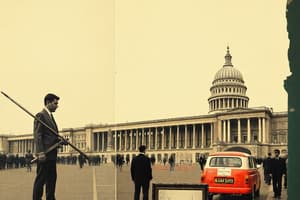Podcast
Questions and Answers
Which of the following is NOT a responsibility of the Executive Office of the President (EOP)?
Which of the following is NOT a responsibility of the Executive Office of the President (EOP)?
- Casting tie-breaking votes in the Senate (correct)
- Managing the president’s agenda
- Overseeing implementation of presidential policies
- Formulating policies and decisions
Members of the Executive Office of the President require Senate confirmation.
Members of the Executive Office of the President require Senate confirmation.
False (B)
What is one of the key duties of the Vice President?
What is one of the key duties of the Vice President?
Presides over the Senate
The members of the President's Cabinet help implement the president's _____ and policies.
The members of the President's Cabinet help implement the president's _____ and policies.
Match the following roles with their main responsibilities:
Match the following roles with their main responsibilities:
Which of the following describes a primary function of the President's Cabinet?
Which of the following describes a primary function of the President's Cabinet?
The First Spouse always holds an official government position.
The First Spouse always holds an official government position.
Who typically appoints the members of the Executive Office of the President?
Who typically appoints the members of the Executive Office of the President?
What is the primary role of civil servants?
What is the primary role of civil servants?
Civil servants are primarily appointed based on political considerations.
Civil servants are primarily appointed based on political considerations.
What procedure must agencies follow to modify regulations?
What procedure must agencies follow to modify regulations?
The group of 15 executive department heads who implement the president's agenda is called the _____ .
The group of 15 executive department heads who implement the president's agenda is called the _____ .
Which of the following is a step in the rule-making process for regulations?
Which of the following is a step in the rule-making process for regulations?
What is a bureaucracy?
What is a bureaucracy?
Regulations allow the government to exercise control over individuals and corporations by _____ certain behaviors.
Regulations allow the government to exercise control over individuals and corporations by _____ certain behaviors.
Match the following terms with their definitions:
Match the following terms with their definitions:
Flashcards
Executive Office of the President (EOP)
Executive Office of the President (EOP)
Group of agencies assisting the president in policy-making, national security, and administration.
EOP functions
EOP functions
Advising the president, managing their schedule, and executing presidential orders.
Vice President duties
Vice President duties
Presiding over the Senate, filling in for the president, and taking on special assignments.
First Spouse role
First Spouse role
Signup and view all the flashcards
President’s Cabinet
President’s Cabinet
Signup and view all the flashcards
Cabinet member's duties
Cabinet member's duties
Signup and view all the flashcards
Bureaucracy
Bureaucracy
Signup and view all the flashcards
EOP Appointments
EOP Appointments
Signup and view all the flashcards
Civil Servants
Civil Servants
Signup and view all the flashcards
Regulations
Regulations
Signup and view all the flashcards
Notice-and-Comment Procedure
Notice-and-Comment Procedure
Signup and view all the flashcards
Political Appointees
Political Appointees
Signup and view all the flashcards
Regulation Creation
Regulation Creation
Signup and view all the flashcards
Study Notes
Executive Office of the President (EOP)
- EOP: Assists the president in carrying out duties, offering policy-making, security, and administrative support.
- Key advisory bodies: White House staff, National Security Council, Office of Management and Budget, Council of Economic Advisers, etc.
- Responsibilities: Policy/decision formulation, agenda management, legislative relations, and implementing presidential policies.
- Appointments: Made by the President, don't need Senate confirmation; often based on political needs, trust, or expertise.
Vice President
- Duties: Preside over the Senate, cast tie-breaking votes, assume presidency if necessary (incapacitation, resignation, death).
- Additional tasks: May handle special assignments relating to domestic/international policy.
First Spouse
- Role: Primarily ceremonial, public advocacy, supporting causes of interest.
- Representation: Represents the country at events, supports presidential initiatives, and champions social/cultural issues.
- Variation: Role varies significantly based on the individual.
President's Cabinet
- Composition: Heads of executive departments (e.g., Secretary of State, Defense, Attorney General), and other key officials like the Vice President.
- Function: Advises the President, helps implement policies.
- Department Heads' Role: Manage specific areas of policy/administration, advise the President, and implement executive orders/policies.
Bureaucracy
- Definition: Government agencies/departments responsible for implementing laws, policies, and services.
- Personnel: Typically non-elected, career professionals.
- Daily Operations: Carry out day-to-day governmental functions.
Civil Servants
- Definition: Government employees working for federal, state, or local agencies.
- Hiring: Based on merit & qualifications, not political appointments.
- Role: Implement government policies/programs.
Bureaucrats/Civil Servants Responsibilities
- Managing public services, enforcing laws, administering programs, and ensuring efficient governmental operations.
- Tasks: Vary from processing benefits applications to managing large-scale public health programs.
Regulations
- Definition: Rules/directives issued by government agencies, implementing Congressional laws.
- Details: Provide specifics on how laws are applied and enforced.
- Creation Process:
- Agencies draft proposed rules, publish in Federal Register for public comment.
- Revisions made based on feedback.
- Final regulations published, implemented, and enforced by agencies; can be reviewed judicially.
Vocabulary
- Executive Office of the President (EOP): Support staff to the President.
- Cabinet: Executive department heads implementing the Presidential agenda.
- Notice-and-comment procedure: Step in the rule-making process (Federal Register).
- Regulation: Rules enabling government control over individuals/corporations.
- Political appointees: People selected to government positions by an elected leader.
- Civil servants: Employees of government bureaucratic agencies.
- Bureaucracy: System of civil servants and political appointees implementing government decisions (often called "administrative state").
Studying That Suits You
Use AI to generate personalized quizzes and flashcards to suit your learning preferences.




